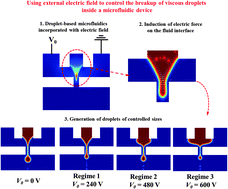Control of the breakup process of viscous droplets by an external electric field inside a microfluidic device
Abstract
Droplet-based microfluidic devices have received extensive attention in the fields of chemical synthesis, biochemical analysis, lab-on-chip devices, etc. Conventional passive microfluidic hydrodynamic flow-focusing devices (HFFDs) control the droplet breakup process by manipulating the flow ratios of the continuous phase to the dispersed phase. They confront difficulties in controlling droplet sizes in the dripping regime especially when the dispersed phase has a large viscosity. Previous studies have reported that an external electric field can be utilized as an additional tool to control the droplet breakup process in microfluidic devices. In this computational fluid dynamics (CFD) study, we have investigated the effect of an external static electric field on the droplet breakup process using the conservative level-set method coupled with the electrostatic model. The numerical simulations have demonstrated that the interaction of the electric field and the electric charges on the fluid interface induces the electric force, which plays a significant role in controlling the droplet formation dynamics. If the microfluidic system is applied with the electric field of varying strength, the droplet breakup process experiences three distinct regimes. In Regime 1, where low electric voltages are applied, the droplet size decreases almost linearly with the increase of voltage. Then the droplet size increases with the applied voltages in Regime 2, where the electric field has moderate strength. In Regime 3, where very large voltages are applied, the droplet size decreases with the applied voltage again. These interesting variations in the droplet breakup processes are explained by using transient pressure profiles in the dispersed phase and the continuous phase. The droplet breakup processes regulated by an external electric field that are revealed in this study can provide useful guidance on the design and operations of such droplet-based systems.


 Please wait while we load your content...
Please wait while we load your content...